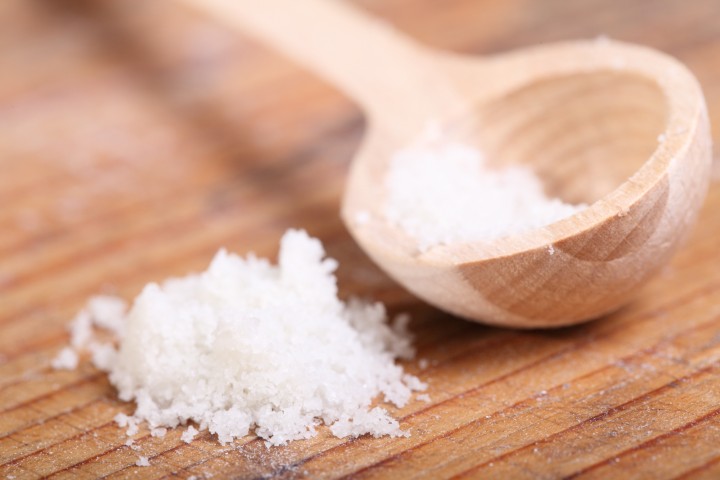
If you want to find out what salt does for your loaf, try and leave it out and take a bite…
Klik hier voor de Nederlandse versie
A while ago we took a closer look at the percentage of salt we put into our bread. If you are a big bread eater, chances are high you get a lot of your daily salt intake via your sandwiches.
The UK recently came out with a new standard for the amount of salt in bread baking. So we tested this new standard to find out what the effect would be for our own bread baking and want to share the result with you…
First, some things you need to know about salt and bread baking:
What does salt do?
- Salt acts as a natural antioxidant in the dough and not only adds taste but especially helps bring out the flavors and aromas present in the flour and other ingredients.
- Next to its role in boosting the flavor of your bread, salt plays a role in tightening the gluten structure and adding strength to your dough. It helps the loaf to hold on to the carbon dioxide gas that is formed during fermentation, supporting good volume.
- Salt slows down fermentation and enzyme activity in dough. The salt crystals draw water away form their environment (salt is ‘hygroscopic’). When salt and yeast compete for water, salt wins and the yeast is slowed down.
- Because of its moisture maintaining properties, salt can prevent bread from getting stale but it can also (this is especially true in humid environments) absorb moisture from the air and leave you with soft crusts and soggy bread.
How much salt is considered normal in bread baking?
In bread baking the percentage of salt added that is considered normal, ranges from 1.8% to 2.2% of the total amount of flour, depending on the recipe and personal preference. Low salt contents can lead to bland loaves, anything over the 2.2% norm will likely be considered too salty. The UK recently came out with a new standard of 1 gram of salt per 100 grams of the final baked bread or about 1.5 to 1.6% of the total amount of flour. So instead of a percentage of salt to flour, they give the amount of salt per 100 gram of the actual finished product / bread.
Should I be afraid of salt touching my yeast?
Short answer: NO! Usually you add salt and yeast to your flour and immediately start mixing. It is totally unnecessary to put salt on one side and yeast on the other and seconds later start mixing them together anyway. You do not want to add salt on top of fresh yeast and leave it for minutes because then the salt will indeed kill the yeast.
What type of salt should I use for bread baking?
All salt is good, as long as the salt crystals are fine enough and dissolve easily. A lot can be said for different types of salt, some contain additives, some have other minerals next to the sodium chloride (NaCl) considered beneficial for you (like Celtic sea salt which is also lower in sodium). You can make up your own mind as far as the health benefits go, taste wise it will not make a big difference to your loaf. Due to the relatively small quantity of salt it would be really hard to detect subtle differences in flavor.
Our own findings with the new salt content standard
So, we looked at our own baking and did a test with this new UK standard of 1 gram salt per 100 grams baked loaf. For example, for a standard pain rustique (750 g dough, weighing about 680 g after baking) this would mean lowering the added salt from 8 g to 6.8 g or from 1.17 g to 1 g per 100 g bread.
Examples of bakers percentages for a loaf of pain rustique:
2.2% of total flour would mean almost 10 g of salt added to the recipe
2% – about 9 g of salt
1.8% – just over 8 g of salt
1.5% – about 6.8 g of salt (the new UK standard)
We tested and tasted the bread with new, lower salt content several times, together with some bread friends. Result: We all had a very hard time noticing any difference. There is a line below which it would become noticeable of course, but this new standard is no problem for us. We have to add that using high quality (organic) flour also makes a big difference in taste and perception of saltiness. Also see our flour experiments. To enhance flavor, salt has to have something to work with, and it will have a hard time bringing out any flavor when the flour you work with is overly processed and bland to begin with!
We now use it in most recipes for our daily bread, except when making dough for things like pizza and focaccia and other flatbreads. For these special breads our personal preference is to make this dough a bit saltier.
Let us know your thoughts on salt!



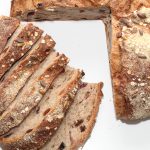

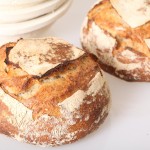
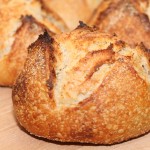
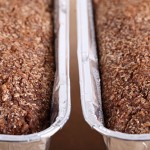

Margo Newman says
Amount of salt in crust of bread?
Weekend Bakers says
Except for playing a role in the color of the crust, we would not know if there is a difference in the amount of between the crust and the crumb.
Michel says
Very informative article.
I use about 0.5% salt (baker’s %) with locally milled high extraction (83%) and/or whole grain flours. I find that my bread tastes quite good. I am used to a pretty low salt diet though.
I am finding I sometimes need to slightly reduce the water and be mindful of the fermentation since it goes faster with less salt; overproofing can happen more quickly.
In the past, I have even eaten no salt bread but haven’t tried baking a no salt bread myself.
Weekend Bakers says
Thank you Michel for your thoughts and sharing of expertise on the subject.
We once forgot to add the salt to a baguette recipe and it turned out pretty good to the eye. Only after tasting we discovered the omission. Only in hindsight we could probably have established the proofing was a bit quicker, but maybe contributed that to other factors too.
Not too long ago we had to get used to saltless bread on a trip to Tuscany in Italy. Bread with (some) salt is better, but with the right accompaniments and good quality of the bread and bake itself it is not as bad as you might think beforehand.
Enjoy your ‘right amount of salt’ bread baking!
Constance Rowell Carson says
Wondering when to add salt to my sourdough. When the breadflour and water and starter go in? Just don’t want to sabotage the leavening process. I will experiment with your salt to loaf ratio with this next loaf.Any feedback would be appreciated. I used 12gr of seasalt for 500 gr breadflour and 100 gr of starter.
Weekend Bakers says
Hello Constance,
It depends on the method of the recipe, but it is never a bad idea to add salt as the last ingredient to go in when making the final dough. If something like ‘autolyse’ is included in the recipe, you always add the salt after this stage.
On the other hand, you should not feel apprehensive about adding salt with other ingredients, when you start mixing and incorporating everything the next instant anyway. Nothing bad will happen. It’s just when salt and yeast come into direct contact for longer that the yeast will not like this and eventually get inactive.
See our recipe here for the method and the ‘autolyse’ part:
www.weekendbakery.com/posts…n-naturel/
Good luck with the baking and hope you like the bread with a little less salt.
Peter A says
I have been adding 11g of salt to 450g of flour for years. Aftewr reading the above, I am going to try reducing it, starting with 7g. (I do have a kidney/potassium problem ).
Weekend Bakers says
Hello Peter,
We hope reducing salt in your daily bread will benefit your health. We are sure by decreasing the salt level gradually, you will have no problem getting used to the lower salt bread.
Wishing you health and happiness and many enjoyable baking hours
Kehinde Oyedun says
Salt gives taste to a food.
Kaycee says
I have been using 1% as a standard, but now I think I’ll make it 1.5%
Thanks a lot for this article, it’s really enlightening.
Pishgar says
Hi
Thanks for information about salt .
It is very education.
Thanks again.
Mr.pishgar Mohammareza
Janet Shoemaker says
May you find peace in baking
Deborah says
I tend to automatically add less salt than the recipe states. I know I need some salt, but it’s hard to know exactly the point at which the bread would fail without it. I’ll go for 1% and see what happens.